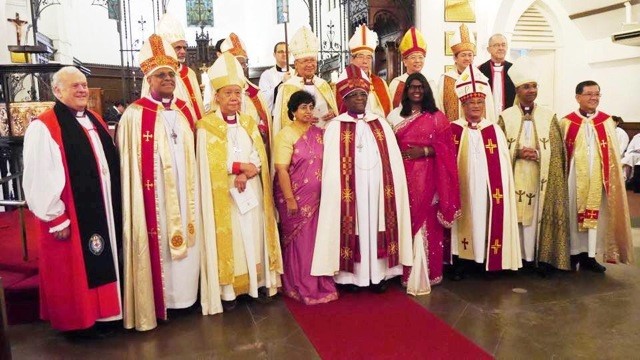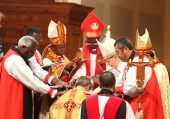
- The Archbishop of Canterbury
- The Primates’ Meeting
- The Lambeth Council of Bishops (every ten years)
- The Anglican Consultative Council
News and opinion about the Anglican Church in North America and worldwide with items of interest about Christian faith and practice.
During my lifetime, the Episcopal Church changed dramatically and one of the biggest changes was in the selection of bishops. Once upon a time, the Episcopal Church elected theologian-bishops like Fitzsimmons Alison of the Diocese of South Carolina or Robert Terwilliger of the Diocese of Dallas. In more recent times the Episcopal Church has been electing nice guy bishops. This trend has been seen in a number of instances and one in particular is the Bishop of Central New York. This is his statement on last week's decision by the primates of the Anglican Communion: 21 Jan 2016 Author: Gladstone Adams You probably have heard of the decision that has come out of the recent Anglican Primates meeting in Canterbury, England. (The Primates are the head bishops of the various provincial churches that make up the worldwide Anglican Communion, of which our Presiding Bishop is one.) Of the Primates gathered, a majority voted to censure The Episcopal Church for our full embrace of LGBTQ persons, specifically for our most recent General Convention’s action approving inclusive marriage rites that can be used for same-sex couples. According to the Archbishop of Canterbury, Justin Welby, the Primates' decision is not a “sanction” of The Episcopal Church, but a “consequence” of our theological and pastoral decisions that are not embraced by a majority of the head bishops of the Anglican Communion. Whatever the term used, the Primates decided that clergy and lay leaders of The Episcopal Church, for a period of three years, cannot participate in any official Anglican bodies that deal with matters of doctrine or policy. The positive part of the Primate’s declaration is that they unanimously expressed a desire to continue to walk in partnership, joined in Christ in mission and ministry. In my perspective, however, the Primate’s decision to censure The Episcopal Church compounds the pain of discrimination that LGBTQ people have suffered over the centuries and continue to suffer as a result of Church policy. For that pain I am deeply sorry, and as a Bishop of the Church I apologize to all LGBTQ people, especially those of this Diocese. Discipleship can be costly and sometimes, although we do not want it to be so, relationships are strained as part of that cost. People who love God can honestly disagree on weighty matters, and it is my desire to respect and remain in relationship with those who disagree with me. It is my belief, however, that as I read Scripture, understand the teaching of Jesus, examine the history of the Church, and apply God’s gift of human reason seeking the Spirit’s direction, that the actions of The Episcopal Church moving toward full inclusion of LGBTQ people are of God. The Spirit is calling us to stand by our carefully and prayerfully made decisions. We, the people of the Episcopal Diocese of Central New York, will continue to embrace our baptismal promise to “strive for justice and peace among all people and respect the dignity of every human being.” As we believe everyone is made in God’s image, we will continue to work to be a faith community that offers God’s radical hospitality to all, assures everyone of God’s loving embrace, and supports relationships lived in fidelity to God and one another, no matter one’s sexual orientation. All leadership positions of this Church remain open to all who seek the Way of Jesus. The decision of the Primates does not affect us in the every day life of our churches except in one essential way. That is, we must continue to pray for one another and love one another as Jesus has loved us, especially where we may disagree. As the Archbishop of Canterbury said, reconciliation and agreement are not the same thing. I will be attending an Episcopal House of Bishops meeting in March where I may receive much more information and clarity regarding the decisions made and where we may go from here. Until then, God be with you all. I call upon you to remain steadfast in God’s hope as we seek “to be the passionate presence of Christ for one another and the world we are called to serve.” In Christ, Skip [http://www.anglican.ink/article/bishop-central-new-york-responds-canterbury-primates-communique] As you read that statement, did you notice any theology? Of course not, which is the problem in the Episcopal Church. When the leadership of TEC asked the Theology Committee of the House of Bishops to write a theological statement on human sexuality, the statement released in 2003, "The Gift of Sexuality: A Theological Perspective," was roundly criticized by liberal and conservative theologians alike [a conservative critique is found in The Windsor Report and a liberal critique is found here: https://www.rci.rutgers.edu/~lcrew/dojustice/j033.html - there were a number of others from both sides of the theological divide]. The level of theological work is certainly not raised by the Bishop of Central New York, but this is what we've come to expect from him. He told a group that I was a part of in 2003 that he had written a theological statement on the General Convention's action that summer in endorsing the consecration of Vicky Gene Robinson, a divorced man in a committed homosexual relationship, but when he gave it to his staff along with a more personal reflection piece, they thought the reflection piece was a better statement to be published in the diocesan newspaper. Instead of a reasoned affirmation of the General Convention's action, the diocese was given much less. In the statement copied above, the bishop says "as I read Scripture, understand the teaching of Jesus, examine the history of the Church, and apply God’s gift of human reason seeking the Spirit’s direction, that the actions of The Episcopal Church moving toward full inclusion of LGBTQ people are of God." That has about as much weight as the folks who preface or explain their actions with "the Lord told me to do it." People of God, it has been the age-old premise of the Church that the Holy Spirit does not speak or lead contrary to the revealed Word of God, which is the Bible. The bishop next quotes from the 1979 prayer book liturgy, that we are to “strive for justice and peace among all people and respect the dignity of every human being.” In his perspective, to maintain the historic position on sexuality and marriage is to disrespect the dignity of people who hold to other views of sexuality and marriage. It is to deny them justice and to create discord. This is strange thinking considering that it is the same prayer book that has the baptismal covenant from which he is quoting and the wedding service that clearly states that marriage is between a man and a woman. In his statement, do you see any acknowledgment of the discord that TEC has created in the worldwide Anglican Communion by her unilateral actions? Of course not. To do so would require humility. Instead, the victim card is played and the defiance that has marked the words and actions of TEC since 2003 come to the fore. This is what you get when you elect nice guy bishops. What you don't get is theologians who understand how to do the hard work of properly interpreting Scripture. Even a committee of six bishops and "seven academic theologians" [from the Gift of Sexuality] could not adequately do that. And this is precisely the problem in TEC. This is why TEC has been censured by the Anglican Communion. Skip is a nice guy, but hardly a theologian. Unfortunately, the Episcopal House of Bishops is filled with other men and women like him that exhibit the same deficiency.
The heads of the 37 of the 38 provinces of the Anglican Communion were joined by Archbishop Foley Beach, the head of the ACNA. The meeting began on Monday and there was a partial media blackout due to no press conferences being held until Friday and the lack of availablity of the primates during the meeting. Information leaked out in drips and drabs and Anglicans and Episcopalians received what news and conjecture that was released through a variety of sources. The principle sources for reporting on the meeting for the United States were EpiscopalChurch.org, Episcopal Cafe, Virtue Online, Anglican's Online and Stand Firm in Faith. It may be too early to say which was the go to site, but here are the stats according to site metrics from Alexa.com as I write: EpiscopalChurch.org's worldwide rank is 93,868. It's national ranking is 16,300. Episcopal Cafe's worldwide rank is 176,909, with a national ranking of 32,992. Virtue Online's rank worldwide is 349,069. It's national ranking is 59,184. Anglican's Online ranks 413,758 worldwide and 127,986 in the United States. Stand Firm's worldwide rank is 564,827. It's national ranking is 109,191. So, two liberal sites were more popular than Virtue Online, and three liberal sites were more popular than Stand Firm. Interestingly, today, the traffic to the liberal sites were all increasing while the traffic to Virtue Online was down and the traffic to Stand Firm was dramatically down. Alexa.com explains their ranking system, saying, "The rank is calculated using a combination of average daily visitors to this site and pageviews on this site over the past 3 months. The site with the highest combination of visitors and pageviews is ranked #1."


